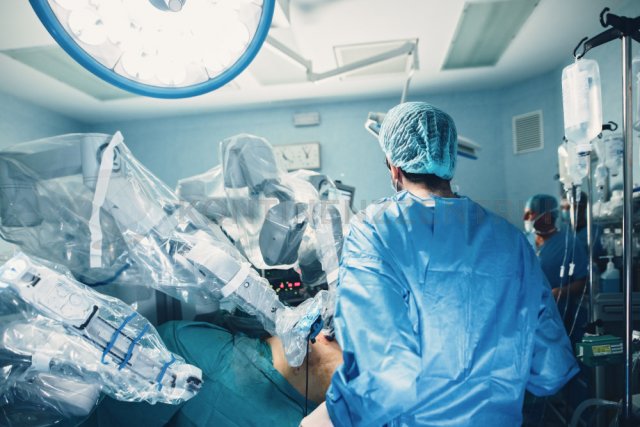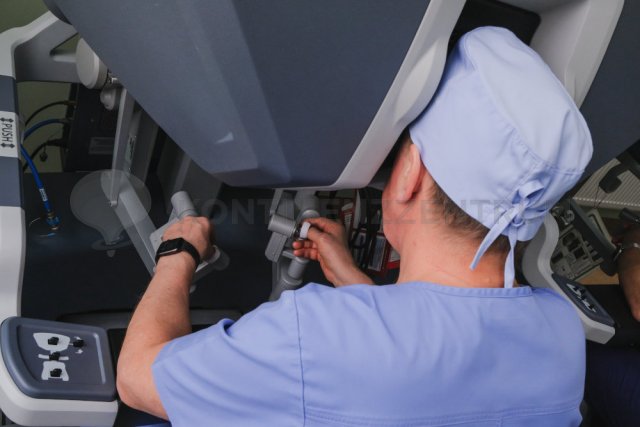Da Vinci surgery: modern method for benign enlarged prostate

Da Vinci surgery is a minimally invasive method for treating a benignly enlarged prostate. This new method of prostate surgery is also known as "transvesical prostatectomy" or "laparoscopic robot-assisted surgery for prostate enlargement". The surgeon removes the inner prostate tissue in a minimally invasive procedure using laparoscopy. The procedure is performed using the Da Vinci surgical robot, which transfers the surgeon's movements to the instruments with extreme precision. A high-resolution camera also provides the doctor with a detailed 3D view of the surgical field, allowing him to make much smaller and more precise incisions. The Da Vinci method on the prostate is used for very large prostates and offers many advantages over conventional surgical procedures.
Do you suffer from benign prostate enlargement? Our specialized specialists at the Hirslanden Continence Centre in Zurich will be happy to advise you on your individual options for diagnosis and treatment.
Find out more
Do you have questions about prostate surgery using the Da Vinci robot or about other treatment options for an enlarged (benign) prostate? Get in touch with our experienced specialists for a consultation! You can reach our center (Continence Center Hirslanden) in Zurich by phone. Our clinic is open Monday to Friday from 8 a.m. to 5 p.m. You can also use our online appointment booking.
Advantages of prostate surgery with robotic assistance
The robot-assisted Da Vinci prostate operation is currently one of the best and most sustainable procedures for prostate surgery. It offers patients the following advantages, among others:
- Less blood loss
- Smaller scars due to smaller incisions
- The patient's tissue and nerve tracts are protected as much as possible
- Shorter healing process due to gentle access to the bladder and prostate
- Less pain after the operation and therefore less use of painkillers
- a shorter stay in hospital
- Good long-term prospects of success: significantly improved bladder emptying, a stronger urine stream and less/no residual urine after the procedure
Differences to conventional methods
Prostate surgery using the Da Vinci robot is a relatively new method of treating benign prostate enlargement. The current standard procedure in many clinics is transurethral resection of the prostate (bipolar TURP). In this procedure, the inner tissue of the prostate is scraped out using an electric snare. The snare is inserted through the urethra. In the method of bipolar enucleation of the prostate tissue, the treatment is carried out using a laser. This procedure is also known as laser resection or vaporization. It is used for severely enlarged prostates. The enlarged inner prostate tissue is removed using a vaporization probe, which is inserted through the urethra. There are also other procedures that can be used depending on the degree of prostate enlargement, the symptoms occurring and the patient's individual circumstances.
These methods are tried and tested and have a good chance of success. Additional incisions in the abdomen or lower abdomen are not required to remove the prostate tissue. For this reason, many men prefer a TUR-P or laser vaporization procedure to an operation involving skin incisions. However, if the prostate is very enlarged, prostate surgery performed through the urethra reaches its technical limits. In this case, prostate surgery using the new Da Vinci method offers a minimally invasive alternative to open surgery. Access via laparoscopy means that a large opening in the abdominal cavity is not necessary, as would be the case with traditional surgical methods. A few small incisions in the area of the navel are sufficient to allow gentle access to the bladder and prostate.
Procedure and duration of prostate surgery with the Da Vinci robot

The procedure is performed under general anesthesia. The doctor first makes several small incisions at the level of the navel, through which the instruments are passed. Through a first incision in the area of the navel, the doctor inserts a small guide sleeve and introduces carbon dioxide into the abdominal cavity through the opening. This creates a cavity in the abdomen, which improves the view of the organs. The doctor inserts additional guide sleeves through further small incisions in the abdominal wall. The arms of the surgical robot (with camera and special instruments) are placed on the guide sleeves. The bladder is first located and opened. The inner, glandular part of the prostate, which inhibits the flow of urine, is then peeled out and removed. The bladder is then sutured and a catheter inserted. Prostate surgery using the new Da Vinci method usually takes 1-2 hours.
During the operation, the robot-assisted systems transmit the surgeon's hand movements to the surgical instruments on a control console in a 5:1 ratio, free of tremors and digitally scaled. This allows the surgeon to make much smaller and more precise incisions. The robot-assisted systems allow the surgical instruments to be rotated 360 degrees, enabling incision and suture techniques that cannot be performed using conventional surgical techniques. During the procedure, the surgeon can see the surgical area magnified ten times with a high-resolution 3D camera and therefore has a three-dimensional view. This results in improved depth perception. Thanks to its ergonomic operability, the robot-assisted system helps the doctor to work in a more relaxed manner and to tire less quickly. The robot only ever performs the movements specified by the surgeon. Additional safety protocols prevent involuntary and excessive movements by the surgeon on the surgical instruments.
What should patients consider before and after the operation?
Before undergoing Da Vinci surgery on the prostate, patients should inform their doctor about the medication they are taking. The doctor will then decide whether and when these should be discontinued or replaced by other medication. This applies in particular to anticoagulant medication, but also to medication containing metformin (for diabetics).

After surgery using the Da Vinci method on the prostate, various catheters are inserted to flush and drain the bladder. This prevents the formation of blood clots and blockage of the catheter. Fluid or blood that accumulates outside the bladder can drain away. Before the catheter is removed, an X-ray check of the suture on the bladder is often carried out. The patient can usually leave the hospital after 5 to 7 days.
Patients should drink plenty of fluids after the operation to flush the bladder and urethra thoroughly. In the first three weeks after the operation, patients should also avoid exertion such as lifting heavy loads or going to the sauna. You should also refrain from cycling or motorcycling for at least four weeks. You should discuss with your urologist when you can resume sporting activities or cycling.
In order for the patient to regain urinary control quickly and permanently, targeted pelvic floor training or training of the urethral sphincter muscles is very important. Please follow the recommendations of your doctor.
In some cases, a urinary catheter remains in place after discharge from hospital. Affected men learn how to use it in hospital. The catheter can usually be removed on an outpatient basis after about a week.
Patients should be conscientious about their aftercare and make sure they attend any follow-up appointments scheduled by their doctor. If symptoms or a fever of over 38 degrees occur immediately or a few days after the operation, inform the doctor immediately.
Important information on cancer screening
Since the Da Vinci method for treating a benignly enlarged prostate preserves the outer tissue, the risk of prostate cancer remains. Patients should therefore continue to attend regular cancer screening appointments with their urologist.
Find out more about the Da Vinci method for prostate surgery
Contact us for a consultation and we will be happy to inform you about your individual assessment and treatment options and about prostate surgery with the DaVinci robot. You can reach our center (KontinenzZentrum Hirslanden) in Zurich by telephone. Our clinic is open from Monday to Friday between 8 am and 5 pm. You can also make an appointment online!
